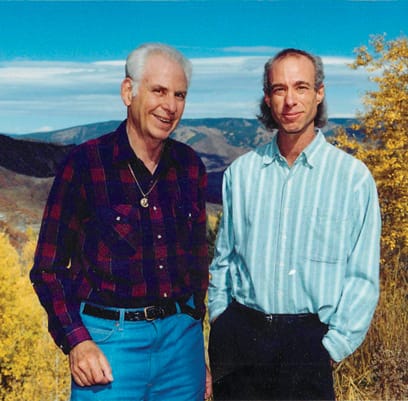This article is from our archives as part of the 100th issue special, celebrating twenty-five years of quarterly newsletters.
A reflection on how our founders came to “natural investing” over thirty years ago, planting the seeds for today’s vibrant Natural Investments group, which includes twenty advisors all across the U.S. helping clients manage a half billion dollars in regenerative and conscious capital.
Photo: Jack Brill, founder of Natural Investments, with his son and partner Hal Brill.
“Yes, this is Mr. Brill, rep number 638, with an order to sell 4,000 shares of Exxon at market.” I completed the trade for my client and stepped out of my office with a satisfied smile. I had just helped a conscientious investor divest herself from a company whose environmental transgressions offended her. And look where I was! The Wall Street clerk taking my order must have pictured me in a stuffy brokerage suite with ticker tapes flashing. But in 1992 I had taken refuge in a relic travel trailer parked on a friend’s high desert acreage outside of Santa Fe, New Mexico. Along the south side I built an arching sunroom with straw-bale walls. A 500-foot extension cord and phone line snaked through the pinyon and juniper trees, linking me and my laptop to the world. I wore Guatemalan shorts to work, not a pinstriped suit.
Today, each of us must find our path through the economic world, making choices about how we earn, spend and invest. We are bombarded with aggressive messages about investing. Wild fluctuations of the Dow (or now, the dot com stocks of the NASDAQ) dominate the news. On-line brokers entice us with point-and-click trading; millions seek jackpots in the stock market as if it were a casino. But money is not a game. Our daily economic choices have powerful consequences. What is the goal? Will getting rich solve our personal and planetary dilemmas? What kind of future do we want for ourselves, our children, our communities and the world?
Dumping my client’s Exxon stock was a tiny act in the context of the global economy. Yet it is indicative of one of the most hopeful directions of our times. A large and growing segment of the public – both individual and institutional investors – are engaged in the revolutionary act of investing consciously. They are demanding that their investments produce more than profit; they want companies they own stock in to behave responsibly. US News & World Report recently called socially conscious investing one of the “hot new trends.” Although it is not really new (colonial Quakers were screening out slavery-related investments centuries ago) it certainly is hot. A 1999 study by the Social Investment Forum reveals surprising findings: assets involved in what is commonly called Socially Responsible Investing, or SRI, now total $2.2 trillion. This represents one out of eight dollars under professional management in the U.S. today. In just two years from 1997 to 1999, SRI assets soared by 82 percent.
This is a hefty chunk of cash, and it is growing fast. Heavy hitters like Salomon Smith Barney, Neuberger Berman, Dreyfus and TIAA-CREF now offer socially-screened investment services. Vanguard, the $500 billion mutual fund behemoth, just announced a partnership with the Calvert Group (who will do the social screening) to launch a Social Index Fund. Vanguard’s fourteen million investors will soon be hearing about SRI, many for the first time. Meanwhile, stalwart SRI companies like Calvert, Citizens, Domini, Pax and many others are on a rapid growth curve.
Investing with Passion
It used to be that investing was primarily the province of the wealthy elite. But now we’ve become a “Nation of Investors” as a majority of Americans are in “the market.” This challenges us to become informed and take actions that are aligned with our life’s purpose. One of the things I love about working with people and their money is that it touches our deepest core issues. Natural Investing aims to serve the whole person, helping us navigate the murky waters of personal finance. How to provide for us and families while staying true to our values? Is it even possible?
Natural Investing is not a one-size-fits-all solution. And it does not promise purity in a world full of contradictions. I know of no perfect investments – every company has its flaws. What it does offer is a map of the territory, guiding each of us to make decisions that balance all of our goals, financial and personal. It has taken me a long time to embrace this path. As a student in Berkeley, then working as an environmental educator and sustainability advocate, Wall Street was clearly the belly of the beast. Its profit-hungry tentacles were pillaging the Earth and impoverishing the masses.
I came across Socially Responsible Investing in the mid-eighties and regarded it with a mixture of enthusiasm and skepticism. The concept was great: directing capital away from destructive activities and towards the creation of life-enhancing enterprises. Community-based investing was especially juicy for me. I dove in with a grassroots coalition that created a community loan fund in New Mexico. But I was suspicious of SRI’s involvement in the nefarious empire of stocks and bonds. How could a few “green investors” make a difference in that world? SRI was a mere sprout compared to the industry it is today. The press either ignored or attacked it, and much of alternative culture (like me) was still rebelling against the whole idea of making money.
Then in the early nineties, two events coincided that turned my career path upside down. First, the nonprofit that I co-founded for the purpose of creating a model intentional community went broke. This personal crisis taught me many lessons, including a realization of the central role that money plays in our society. Second was a surprising turn in my relationship with my father, Jack. He had recently made a big shift himself, leaving a career as a quality control engineer with the U.S. Navy to become an investment advisor. I had casually sent Jack some information on SRI, and to my amazement he totally embraced the idea. Jack started writing a column for the food co-op in San Diego, and in a short time the press turned him into a spokesman for SRI. In 1991 he hired me to do research for his first book, Investing from the Heart.
As I gained expertise in the field, Jack suggested that I get licensed to become a broker. This seemed ludicrous at first. I didn’t see the potential of SRI to become a major player in the global economy, nor did I realize that the movement was poised for exponential growth. It took some time, but eventually I grokked what was going on: conscientious people were beginning to get their hands on the financial levers that run our society. This was a very exciting realization. If the movement grew, we would have a strong voice in the corporate world and have the tools to create a more just and sustainable economy. I didn’t have to live outside the mainstream – I could help move the mainstream!
Making a Difference with our Money
The process of infusing consciousness into capitalism is a bit like eroding a stone with drops of water. Collective action over time ultimately wears away the resistance. Witness the remarkable turnaround of Home Depot in 1999. Forest activists had spent fruitless years pressuring Home Depot (the largest seller of lumber in the world) to cease selling old-growth forest products. Then, at the company’s annual meeting, shareholders activists were treated roughly by security. This became a public relations nightmare. Several weeks later, the company announced a new policy (claiming it had nothing to do with the protests) that will eliminate purchase of certain old-growth lumber and increase purchases of lumber certified to be sustainably harvested.
Victories like this are sweet, but SRI is still in its infancy. It must grow in order to gain the clout it needs to address critical social and environmental issues. Our desire to help this happen is what prompted Jack and I to team up with Cliff Feigenbaum, founder of the GreenMoney Journal. We spent two years researching and writing Investing with Your Values, knowing that prospective investors needed a comprehensive guidebook. We thought this would be a small self-publishing venture, appealing mainly to the alternative marketplace.
Imagine our shock when we were contacted by Bloomberg, the Wall Street information dynamo! Their support is yet another sign that values-based investing is planting itself firmly in the economic landscape. The Dalai Lama said that “as people see their predicament clearly – that our fates are inextricably tied together, that life is a mutually interdependent web of relations – then universal responsibility becomes the only sane choice for thinking people.”
Ultimately it is this change in consciousness that is our best hope for the future. As we learn that the inner and the outer are connected, our actions – including our financial choices – will naturally align with values that move us towards a sustainable future.

